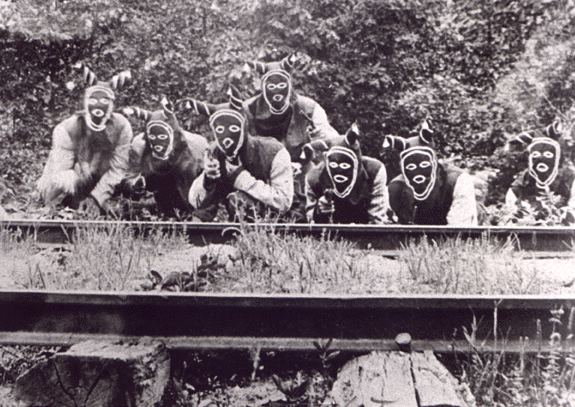Spatial@ucsb recently hosted a series of “Spatial Lightning Talks,” a series of “delicious, rapid-fire talks on geographically-flavored topics”; the presenters, including Geography faculty and graduate students, were allotted a maximum of three minutes and ten PowerPoint slides. Predictably, Professor Dan Montello’s presentation, titled “Baldknobbers of the Ozarks,” was a major attention-getter (with a name like that, it’s got to be good!). The following is cobbled together from Dan’s notes:
Branson, Missouri bills itself as “The Live Music Capital of the World.” The venue is devoted primarily to country and western music and is considered second only to Nashville, Tennessee in that respect. Branson’s emergence as a center for country music (and comedy) began when the Mabe family began entertaining local fishermen with hillbilly music and humor on the downtown Branson lakefront in 1959. They called themselves the Baldknobbers, and the second generation Mabe family has continued the popular tradition. But the original Baldknobbers were much more interesting!
The story begins with the Civil War. Missouri was split over the issue of slavery, and many communities had neighbors and families fighting on both sides of the war. After the war, Taney County (which includes Branson), located along the Missouri-Arkansas border, was particularly devastated, with bushwhackers and outlaws roaming the countryside, robbing and killing in the name of both the Union and the Confederacy. As a result, the county became indebted and depopulated, government for the most part ceased to exist, and anarchy reigned. Locals, mostly Southern Democrats, became used to turning their heads the other way when it came to criminal activity. Taney was considered a haven for the outlaws and lawbreakers of the Ozarks, who flocked to the area.
During the 1870s and 80s, new settlers began to immigrate to Taney County, mostly law-abiding Republicans from the north; they brought an expectation of law and order, and, thus, the stage was set for conflicts between the settlers and the locals. In the mid-1880s, a settler named Nathanial Kinney (who had been in the Union army), a muscular giant of a man who stood well over 6’ 6” and weighed over 300 pounds, organized a secret vigilante group in response to the acquittal of a local murderer (accusations of jury tampering and bribery were made).
Kinney’s vigilantes called themselves the Baldknobbers, taking their name from their meeting place at Snapp’s Bald – and here’s where the geography kicks in. A bald is an area on a rounded knob or mountain top which is treeless: “In the Appalachian Mountains of the eastern United States, balds are mountain summits or crests covered primarily by thick vegetation of native grasses or shrubs occurring in areas where heavy forest growth would be expected. Balds are found primarily in the Southern Appalachians, where the climate is too warm to support an alpine zone—upper areas where trees fail to grow due to short or non-existent growing seasons—even at the highest elevations” (Wikipedia).
But back to the history. The Baldknobbers decided to provide their own brand of law and order, the “homeland security” they believed the county government would or could not provide. Secret resolutions were soon drawn up, along with secret initiation ceremonies, handshakes, passwords, and signals. The Baldknobbers took the law into their own hands and punished lawbreakers and “evildoers” with lynchings, beatings, and the like, typically leaving notes which read, “BEWARE! These are the first victims to the wrath of outraged citizens. More will follow. THE BALDKNOBBERS.” Many well known criminals left Taney County within days of one particularly celebrated lynching.
Eventually, the Baldknobbers dissolved when Kinney was shot dead. However, the Baldknobbers of Taney County influenced others in adjacent counties, and it was this new group that gave the Baldknobbers their notoriety and exhibited the greatest degree of violence, forsaking law and order to become a thrill-seeking gang of criminals in their own right, riding into the night wearing black skull masks adorned with red horn-like appendages. By the early 1900s, these groups too were brought to justice, and law and order was restored by local and state law enforcement.
Editor’s note: more on the subject of the notorious Baldknobbers can be found at Wikipedia and at legendsofamerica.com; more about balds can be found here and here; and, if you’re into country and western musical comedy, check out the modern Baldknobbers web site.







